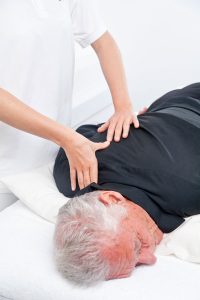What is the Bowen Technique?
The Bowen Technique is an effective, gentle non invasive soft tissue therapy. There is no force or manipulation involved. It is a holistic treatment which means that it treats the body as a whole. It is suitable for people of all ages, from young babies to the very elderly.
The aim of the Bowen Technique is to relax and rebalance the body by facilitating the bodys’ own natural resources to release stress at a very deep level, which potentially eases muscular pain, promotes pain relief and aids the recovery of natural energy throughout the body.
The treatment involves the therapist making precise gentle rolling type movements, using fingers and thumbs over muscle, tendon and soft tissue on certain areas of the body. It is designed to stimulate neural pathways and affects the nervous systems of the body. The Bowen Technique treats the whole body rather than just the area of concern.
As all parts of the body are connected to each other, it follows, that an issue with one part of the body may be influenced by a condition in another area of the body. It is not uncommon for a client to seek treatment for a particular issue and then notice an improvement in an apparently unrelated condition in a different area of the body following their Bowen treatment. Many clients have reported an improvement in unrelated conditions, which they may have forgotten to mention during their initial consultation.
Most importantly, many clients report a deep feeling of relaxation and stress relief in the few days following their Bowen treatment. Some clients have also experienced an improvement in their concentration levels, quality of sleep and positive outlook on life.
What are the origins of the Bowen Technique
 The Bowen Technique was developed in the 1950s by Tom Bowen in Geelong, Victoria, Australia. He realised that ill health developed when the bodys’ muscle tensioning system was disrupted and misaligned. He devised his technique using his fingers and thumbs to do specific movements, which rebalanced the body by releasing stress at a different level. He developed his method throughout his life, treating thousands of people, many of whom travelled hundreds of miles for treatment. Following his death in 1982, his six trainees went on to teach their interpretation of his technique. The Bowen Technique made its first appearance in Britain and Europe in 1995.
The Bowen Technique was developed in the 1950s by Tom Bowen in Geelong, Victoria, Australia. He realised that ill health developed when the bodys’ muscle tensioning system was disrupted and misaligned. He devised his technique using his fingers and thumbs to do specific movements, which rebalanced the body by releasing stress at a different level. He developed his method throughout his life, treating thousands of people, many of whom travelled hundreds of miles for treatment. Following his death in 1982, his six trainees went on to teach their interpretation of his technique. The Bowen Technique made its first appearance in Britain and Europe in 1995.
What happens when I come for a treatment
An initial consultation will be taken where I will take full details from you about your medical history, including any problems you are currently experiencing. The range of your movement may also be assessed if necessary. Treatment will be given with you lying face down on the couch. Halfway through the treatment, you will be asked to turn over and further treatment will be given on the front of your body. There are short periods of a few minutes between each series of Bowen moves, where I will leave the room. These breaks are an essential part of the therapy, allowing the body the time it requires to rest and absorb the treatment. At the end of the session you will be given a glass of water and asked to sit quietly for a few minutes to allow time for your body to adjust from its deeply relaxed state.
PLEASE NOTE - If you find it more comfortable, you may be treated in a seating position, rather than on a couch. I always ensure that clients are fully comfortable before commencing Bowen treatment to ensure that they will gain maximum benefit from their session.
Conditions which may respond to the Bowen Technique include:
- Ankle/Foot problems
- Carpal Tunnel
- Competitive sports preparation and injury
- Elbow problems
- Fatigue
- Frozen shoulder
- Hamstring problems
- Jaw function problems
- Lymphoedema
- Musculoskeletal problems
- Pregnancy problems
- Postural problems
- Respiratory problems
- RSI (repetitive strain injury)
- Shoulder problems
- Stress related issues
- Tennis/Golfers elbow
- Urinary problems.



